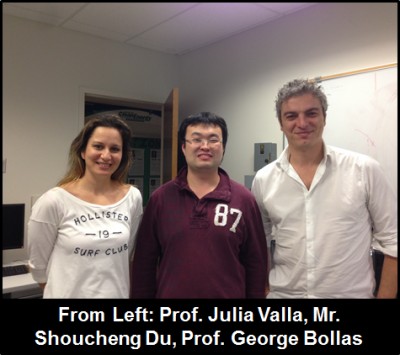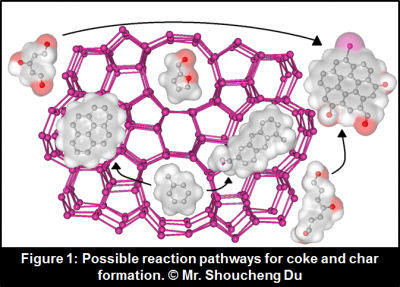 The Board of Directors of the American Institute of Chemical Engineers has elected Dr. Doug Cooper as a Fellow of AIChE. To be considered for the honor, a candidate must practice chemical engineering for at least 25 years, and be a member of AIChE for at least ten. Election as Fellow recognizes both service for the betterment of society and the profession, and professional accomplishment in engineering, management, research, education, or entrepreneurship.
The Board of Directors of the American Institute of Chemical Engineers has elected Dr. Doug Cooper as a Fellow of AIChE. To be considered for the honor, a candidate must practice chemical engineering for at least 25 years, and be a member of AIChE for at least ten. Election as Fellow recognizes both service for the betterment of society and the profession, and professional accomplishment in engineering, management, research, education, or entrepreneurship.
Dr. Cooper has excelled in a number of these categories. Currently professor and head of the Department of Chemical & Biomolecular Engineering at the University of Connecticut, Dr. Cooper has also served as Vice Provost for Undergraduate Education at UConn.
His recent academic pursuits focus on helping nontraditional students engage in STEM disciplines. His research focus is on process control system analysis and design. He also has an ongoing interest in mentoring students in entrepreneurship, creativity, leadership, and life-long learning.
Dr. Cooper has authored and co-authored 85 scholarly publications, garnered more than $6 million in research funding from government and industry. In addition, he has been inducted into the Connecticut Academy of Science and Engineering (2004), honored by the Carnegie Foundation as the Connecticut Professor of the Year (2004), and designated as a Teaching Fellow at UConn (2003).
“Most of all,” says Dr. Cooper, “I enjoy interacting with students and guiding their intellectual growth.” He has taught engineering classes at all undergraduate and graduate levels, and has innovated software and supporting materials for teaching automatic process control, now used by 250 academic institutions around the world.
In 2004, Dr. Cooper founded Control Station, Inc., a company that offers a portfolio of industrial process control solutions and services to manufacturers. With a dozen employees, including four chemical engineers, Control Station offers an array of best-in-class technologies for optimizing plant operation.
“I am honored to join the ranks of Fellow of AIChE,” says Dr. Cooper.

 Dr. Yongku Cho, Assistant Professor in the Department of Chemical and Biomolecular Engineering, has received a prestigious and highly competitive
Dr. Yongku Cho, Assistant Professor in the Department of Chemical and Biomolecular Engineering, has received a prestigious and highly competitive  critical backing to enable him to collect pilot data for his innovative ideas. His grant will support Dr. Cho’s research group to develop a novel approach for rapid and reversible knockout of target genes. His group will research which regulated protein levels affect brain circuits. They will specifically study the mechanism of GABAA receptor dysfunction. Deficits in GABAA receptor function have been linked to multiple neurological and psychiatric disorders, such as epilepsy and schizophrenia. With his new technique, he intends to study the role of GABAA receptor interacting proteins, which may lead to therapeutic targets for such diseases.
critical backing to enable him to collect pilot data for his innovative ideas. His grant will support Dr. Cho’s research group to develop a novel approach for rapid and reversible knockout of target genes. His group will research which regulated protein levels affect brain circuits. They will specifically study the mechanism of GABAA receptor dysfunction. Deficits in GABAA receptor function have been linked to multiple neurological and psychiatric disorders, such as epilepsy and schizophrenia. With his new technique, he intends to study the role of GABAA receptor interacting proteins, which may lead to therapeutic targets for such diseases. research at Wisconsin, Dr. Cho is now interested in manipulating these proteins to include new functions. “The broader objective of the work is to engineer antibodies with useful functionalities that they normally would not have,” says Dr. Cho.
research at Wisconsin, Dr. Cho is now interested in manipulating these proteins to include new functions. “The broader objective of the work is to engineer antibodies with useful functionalities that they normally would not have,” says Dr. Cho. Dr. Yu Lei, Associate Professor of Chemical and Biomolecular Engineering at the University of Connecticut, received a US Patent for his explosive detection technology.
Dr. Yu Lei, Associate Professor of Chemical and Biomolecular Engineering at the University of Connecticut, received a US Patent for his explosive detection technology.






 In 2003, researchers realized that green algae respond to high intensities of light using ion channels that sense blue light. The light-activated channels allow ions to flow through the cell membrane, resulting in the initiation of electrical signals called action potentials in neurons. This finding signifies that light energy can be used to trigger electric signals in specific populations of neurons.
In 2003, researchers realized that green algae respond to high intensities of light using ion channels that sense blue light. The light-activated channels allow ions to flow through the cell membrane, resulting in the initiation of electrical signals called action potentials in neurons. This finding signifies that light energy can be used to trigger electric signals in specific populations of neurons. Mr. Shoucheng Du, Prof. Julia Valla, and Prof. George Bollas are making exciting progress in developing the process of biomass catalytic pyrolysis. Their recent achievements are published in Green Chemistry (
Mr. Shoucheng Du, Prof. Julia Valla, and Prof. George Bollas are making exciting progress in developing the process of biomass catalytic pyrolysis. Their recent achievements are published in Green Chemistry (